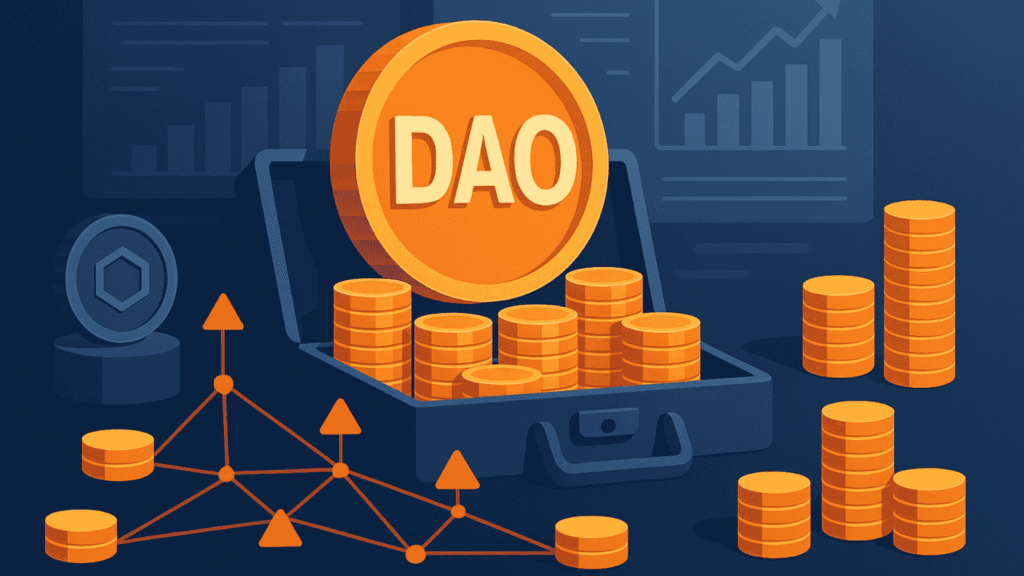The second quarter of 2025 has proven to be a watershed moment for decentralized autonomous organizations (DAOs), as new data reveals that institutional capital inflows into DAO treasuries and governance vehicles have crossed the $2 billion mark. This unprecedented surge marks a shift in how traditional firms interact with decentralized ecosystems—moving beyond observation to participation, governance, and even infrastructure development.
According to analytics firm GovScan, capital contributions from venture funds, Web3-native institutions, and traditional finance entities increased 74% quarter-over-quarter. The influx spans DAOs focused on DeFi protocol governance, decentralized infrastructure funding, and community-led grant allocation, reflecting growing investor confidence in on-chain collective decision-making.
The Institutional Pivot Toward DAO Participation
Historically, DAOs have been associated with grassroots crypto-native communities and experimental governance structures. However, 2025 is redefining this perception. Major financial players are no longer content with passive token holdings or observing governance forums from the sidelines. Instead, they are acquiring voting rights, co-authoring proposals, and deploying capital to shape ecosystem outcomes.
Leading the charge are Web3-native VCs such as a16z Crypto, Pantera, and Framework Ventures, all of whom have recently increased their exposure to governance tokens. Their participation is not just capital-based but strategic: many are contributing research, tooling, and even legal infrastructure to help DAOs scale responsibly.
Traditional institutions, including fintech accelerators and hedge funds, are also exploring DAO involvement. Q2 saw several university endowments and family offices purchase governance tokens via structured vehicles, particularly in infrastructure and real-world asset DAOs, such as those involved in tokenising bonds, real estate, or carbon credits.
Which DAOs Are Leading in Capital Inflow?
Among the most capitalised DAOs this quarter were:
Lido DAO, managing ETH staking and validator strategy, received over $300 million in fresh staking inflows attributed to institutional clients seeking yield with governance rights.
Uniswap DAO, which continues to attract attention due to its active fee-switch debates, posted a $180 million increase in treasury assets after fresh token purchases by institutional participants.
Gitcoin DAO, focused on funding open-source public goods, saw its matching pool contributions rise significantly as non-profits and university-aligned funds contributed to education and climate-focused initiatives.
Ondo DAO, known for bridging tokenized Treasuries and real-world assets, gained favor among fintech institutions, which now hold over 12% of its governance token supply.
The diversity of DAOs receiving inflows suggests institutions are not just chasing yield—they are pursuing strategic alignment with communities that reflect their values, policy interests, or technical edge.
Why Now? Macroeconomic and Regulatory Catalysts
Several macro factors are contributing to this trend. Regulatory progress in jurisdictions like the EU, UAE, and parts of Asia has clarified the legal standing of DAOs, enabling institutions to participate without fear of compliance gaps. Legal wrappers such as Wyoming’s DAO LLC or Switzerland’s DLT Act provide frameworks that bridge corporate governance with decentralized control.
Secondly, the broader stagnation in traditional venture capital returns has prompted firms to explore liquid yet participatory vehicles. DAOs offer this hybrid: a governance token is both an asset and a vote, providing financial upside and strategic influence.
From a market infrastructure standpoint, tools like Snapshot, Tally, and Boardroom have matured significantly, allowing institutional participants to delegate, audit, and track governance outcomes with greater confidence. This level of transparency, coupled with improved user interfaces, makes DAO participation less intimidating and more actionable for new entrants.
The Mechanics of Capital Deployment into DAOs
Institutional capital is flowing into DAOs via multiple channels. Some acquire governance tokens directly on secondary markets or through over-the-counter (OTC) desks. Others engage in structured token sale rounds where DAOs offer future governance rights in exchange for capital injections.
There’s also a growing trend of “delegated stewardship”, where institutions allocate capital to DAO-native asset managers, who then vote on their behalf using predefined mandates. This preserves regulatory distance while enabling directional participation in on-chain governance.
New DAO-focused funds, such as the $200 million “DAO Index Fund” announced this quarter, track a weighted basket of DAO governance tokens. This fund allows institutions to diversify their DAO exposure while backing the protocols driving core blockchain infrastructure.
Risks and Challenges: Decentralization vs. Consolidation
As institutional presence grows, concerns about governance centralization and voter cartelisation are surfacing. In DAOs where a few wallets control a large percentage of voting power, the entrance of well-funded players can tilt the balance, potentially undermining decentralization.
However, some DAOs have responded by implementing governance reforms. These include quorum adjustments, delegated voting, and token lock-up requirements for voting eligibility. Others are experimenting with quadratic voting or dual-token governance to mitigate plutocratic risks.
There’s also a philosophical tension between community ethos and capital logic. While institutions bring funding and credibility, some fear that excessive financialisation may dilute the collaborative spirit of DAOs. Resolving this will require open dialogue, transparent frameworks, and mutual respect between all stakeholders.
What This Means for the Future of DAOs
The Q2 institutional influx signals a new era of DAO maturity. It’s no longer just about community building or decentralization purity; it’s about scalable, resilient governance structures that can handle billions in treasury and deploy them efficiently.
This evolution also repositions DAOs in the broader market. No longer fringe experiments, they are becoming credible economic entities—capable of forming partnerships, issuing grants, launching initiatives, and negotiating with regulators.
Expect to see more DAOs formalise their structures, publish transparent annual reports, and integrate external auditors or governance consultants. With $2 billion in institutional capital now backing the model, the pressure to professionalise has never been higher.
Conclusion
DAOs have crossed a significant milestone in Q2 2025, with institutional inflows surpassing $2 billion and signaling a deeper shift in market sentiment. As capital continues to pour in, the DAO model will need to adapt—balancing decentralization with structure, idealism with execution. If managed wisely, this moment could mark the dawn of DAOs as serious players in both digital governance and mainstream finance. The next frontier? Turning tokenized participation into measurable impact—and proving that collective intelligence can outperform legacy systems.

